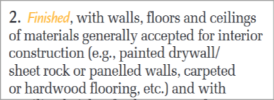From the Selling Guide - It's a pretty simple read actually.
Fannie Says: Gross Living Area
Appraisers must follow the Square Footage-Method for Calculating: ANSI® Z765-2021 ("ANSI standard") when
measuring, calculating and reporting the gross living area and non-gross living areas (basement, additional
structures, etc.) of the subject property for most property types. Appraisals requiring interior and exterior
inspections must follow this standard; appraisals of this type performed without using this standard will not be
acceptable.
Note: The ANSI standard cannot be used to measure apartment-style units in condo or co-op projects;
however, it must be used for any non-apartment style dwellings including townhomes, rowhouses, and
other detached single-family homes. When measuring apartment-style units in condo, or co-op
projects; the appraiser should use interior perimeter measurements. The ANSI standard also does not
apply to two- to four-unit properties.
The most common comparison for one-unit properties, including units in PUD, condo, or co-op projects, is above grade
gross living area and below-grade square footage. The appraiser must be consistent when reporting the
finished above-grade gross living area, below-grade square footage, and room count. The need for consistency
also applies from report to report. For example, when using the same transaction as a comparable sale in
multiple reports, the room count and gross living area must not change.
Only finished above-grade areas can be used in calculating and reporting of above-grade room count and
square footage for the gross living area. Fannie Mae considers a level to be below-grade if any portion of it is below-grade, regardless of the quality of its finish or the window area of any room. Therefore, a walk-out basement with finished rooms would not be included in the above-grade room count.

